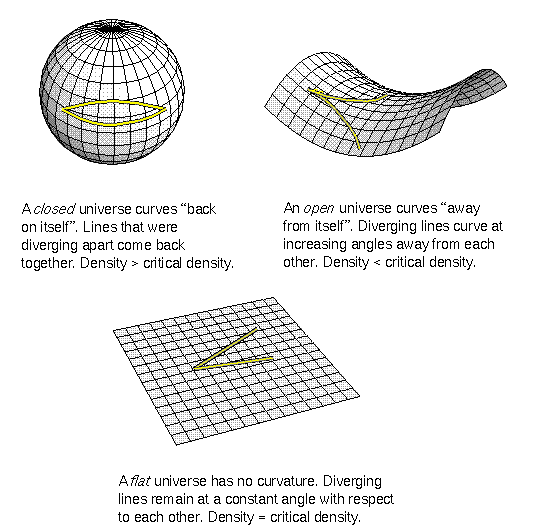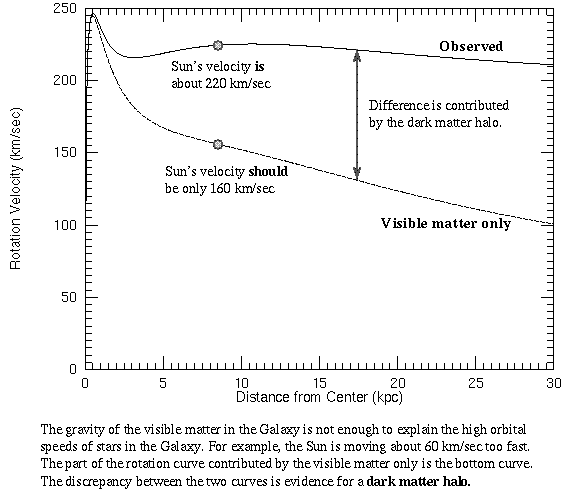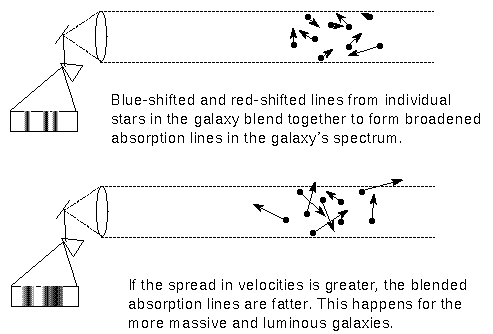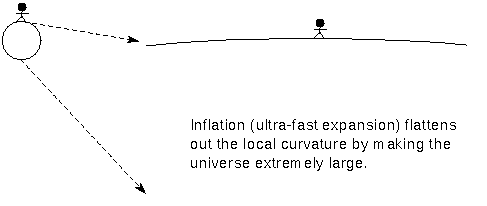Full window version (looks a little nicer). Click <Back>
button to get back to small framed version with content indexes.
This material (and images) is copyrighted!.
See my copyright
notice for fair use practices.
Now that you have explored the beginnings of the universe and have an answer
to the question ``where did we come from?'', let's address the other question,
``where are we going?'' This final section will cover the fate of the universe.
We observe that the universe is expanding and that gravity is slowing it down.
Which of them will win?
The more mass
there is, the more gravity there is to slow down the expansion. Is there enough
gravity to halt the expansion and recollapse the universe or not? If there is
enough matter (gravity) to recollapse the universe, the universe is
``closed''. In the examples of curved space above, a closed universe
would be shaped like a four-dimensional sphere (finite, but unbounded). Space
curves back on itself and time has a beginning and an end. If there is not
enough matter, the universe will keep expanding forever. Such a universe is
``open''. In the examples of curved space, an open universe would be
shaped like a four-dimensional saddle (infinite and unbounded). Space curves
away from itself and time has no end.

Instead of trying to add up all of the mass in the universe, a more
reasonable thing to do is to find the density of a representative
region of the universe. The density = (mass in the region)/(volume of
the region). If the region is truly representative, then the total mass of the
universe = the density × the total volume of the universe. If the
density is great enough, then the universe is closed. If the density is low
enough, then the universe is open. In the popular astronomy magazines, you will
probably see the mass density of the universe specified by the symbol ``W''. It is the ratio of the current density to the ``critical
density'' described in the next
paragraph. If W < 1, the universe is open; if
W > 1, the universe is closed.
 The boundary density between the case
where the universe has enough mass/volume to close universe and too little
mass/volume to stop the expansion is called the critical density. The
critical density = 3H2/(8pG),
where H is the Hubble parameter for our cosmological time. Notice that
the Hubble parameter has appeared again! It measures the expansion rate, so it
should be in the critical density relation. The current critical
density is approximately 1.06 × 10-29 g/cm3. This amounts
to six hydrogen atoms per cubic meter on average overall.
The boundary density between the case
where the universe has enough mass/volume to close universe and too little
mass/volume to stop the expansion is called the critical density. The
critical density = 3H2/(8pG),
where H is the Hubble parameter for our cosmological time. Notice that
the Hubble parameter has appeared again! It measures the expansion rate, so it
should be in the critical density relation. The current critical
density is approximately 1.06 × 10-29 g/cm3. This amounts
to six hydrogen atoms per cubic meter on average overall.
A critical density universe has ``flat'' curvature. The W density parameter equals exactly 1 in a flat
universe. The parameter called the Hubble parameter is different at different
cosmological times. Gravity slows the expansion of the universe, so the early
universe was expanding faster than it is now. That means that the critical
density was greater at earlier times. It changes by the same factor that the
actual density of the universe changes throughout the expansion. So if the
universe starts out with a density greater than the critical density, then its
density will always be greater than critical density. If the universe
starts out with a density less than the critical density, then its density will
always be less than the critical density.
You can do a cosmic
inventory of all of the mass from ordinary matter in a representative region of
the universe to see if the region's density is above the critical density. Such
an inventory gives 10 to 20 times too little mass to close the universe. The
primordial deuterium abundance provides a sensitive test of the density of
ordinary matter in the early universe. Again, you get 5 to 15 times too
little mass to close the universe. However, these measurements do not take into
account all of the dark matter known to exist. Dark matter is all of the
extra material that does not produce any light, but whose presence is detected
by its significant gravitational effects.
There may be about 90 times more
dark matter mass than visible matter. This could be enough to make the
universe's mass density = critical density. Some evidence for the presence of
dark matter has already been presented in the previous chapter. The list below
summarizes the evidence for dark matter's existence.
- Flat rotation
curves of spirals even though the amount of the light-producing matter
falls off as the distance from the galaxy center increases. Remember the
enclosed mass = (orbital speed)2 × (orbit size)/G. Below is the
rotation curve for our Milky Way Galaxy (a typical spiral galaxy).

Also, the orbital speeds of stars in elliptical galaxies are too high to be
explained by the gravitational force of just the luminous matter in the
galaxies. The extra gravitational force is supplied by the dark matter in the
ellipticals.

- Ellipticals have faint gas shells that need massive ``dark'' haloes to
contain them. The gas particles are moving too quickly (they are too hot) for
the gravity of the visible matter to hang onto it. However, the number of
ellipticals with these faint gas shells is too large to be only a temporary
feature of ellipticals. The dark haloes must extend out to 300,000 light years
around each galaxy. The extent of this dark matter pushes W up to around 0.2. If the haloes are larger than
originally thought, W could approach 1.
- Galaxy cluster members are moving too fast to be gravitationally bound
unless there is unseen mass. The reasonable assumption is that we do not live
at a special time, so the galaxies in the cluster must have always been close
to each other. The large velocities of the galaxies in the clusters are
produced by more gravity force than can be explained with the gravity of the
visible matter in the galaxies.
- The existence of HOT (i.e., fast moving) gas in galaxy clusters. To keep
the gas bound to the cluster, there needs to be extra unseen mass.
- Absorption lines from hydrogen in quasar spectra tells us that there is a
lot of material between us and the quasars.
- Gravitational lensing of the light from distant galaxies and quasars by
closer galaxies or galaxy clusters enables us to calculate the amount of mass
in the closer galaxy or galaxy cluster from the amount of bending of the
light. The derived mass is greater than the amount of mass in the visible
matter.
Current tallies of the total mass of the universe (visible and dark matter)
indicate that there is too little matter to halt the expansion---we live in an
open universe. Astronomers and physicists are exploring the possibility that
perhaps there is an additional form of energy not associated with ordinary
matter that would greatly affect the fate of the universe. This is discussed in
the last section of this chapter.
A good book on the history of dark matter is The Dark Matter:
Contemporary Science's Quest for the Mass Hidden in Our Universe by Wallace
and Karen Tucker (New York: Morrow, 1988).
An independent way to measure the overall geometry of the
universe is to determine the largest angular size of the fluctuations in the
cosmic microwave background radiation. If the universe is open, then the
fluctuations are largest on the half-degree scale. If the universe is flat, then
the fluctuations are largest on the degree scale and if the universe is closed,
the fluctuations will be largest on even larger scales. The resolution of the
instruments on the COBE satellite were not good enough to definitively measure
the angular sizes of the fluctuations. A follow-up to the COBE mission called
the Microwave Anisotropy Probe (MAP)
will have the resolution to determine the curvature of the universe to within
5%. To find out more about how MAP will do this, go to their geometry page.
Vocabulary
| closed universe |
critical density |
dark matter |
| flat universe |
inflation |
open universe |
- What is the overall curvature of space in a closed or open
or flat universe? How does the expansion rate compare to the amount of
gravity deceleration in each of these cases?
- Why is the universe's expansion rate slowing down?
- Will it ever slow down completely? How can you find out?
- What type of universe has a critical density? What would happen to
the expansion if the current density < critical density? How about the case
for the current density > critical density?
- Would a universe starting out with a density > critical density ever
expand enough so its density dropped below critical density? Explain why or
why not!
- What is all the fuss about dark matter? If it is not putting out
any light for us to see, how is it known to exist? What are some examples of
observations indicating its presence?
There are a couple of
problems with the standard Big Bang model. The first is called the flatness
problem---why is the universe density so nearly at the critical density or
put another way, why is the universe so flat? Currently, the universe is so
well-balanced between the positively-curved closed universe and the
negatively-curved open universe that astronomers have a hard time figuring out
which model to choose. Of all the possibilities from very positively-curved
(very high density) to very negatively-curved (very low density), the current
nearly flat condition is definitely a special case. The balance would need to
have been even finer nearer the time of the Big Bang because any deviation from
perfect balance gets magnified over time. For example, if the universe density
was slightly greater than the critical density a billion years after the Big
Bang, the universe would have recollapsed by now.
Consider the analogy of the difficulty of shooting an arrow at a small target
from a distance away. If your angle of shooting is a little off, the arrow
misses the target. The permitted range of deviation from the true direction gets
narrower and narrower as you move farther and farther away from the target. The
earlier in time the universe's curvature became fixed, the more finely tuned the
density must have been to make the universe's current density be so near the
critical density. If the curvature of the universe was just a few percent off
from perfect flatness within a few seconds after the Big Bang, the universe
would have either recollapsed before fusion ever began or the universe would
expanded so much that it would seem to be devoid of matter. It appears that the
density/curvature was very finely tuned.
The second problem with the standard Big Bang model is the horizon
problem---why does the universe, particularly the microwave background,
look the same in all directions? The only way for two regions to have the same
conditions (e.g., temperature), is that they are close enough to each other for
information to be exchanged between them so that they can equilibrate to a
common state. The fastest speed that information can travel is the speed of
light. If two regions are far enough apart that light has not had enough time to
travel between the regions, the regions are isolated from each other. The
regions are said to be beyond their horizons because the regions cannot
be in contact with each other (recall the term event horizon in the
discussion about black holes).
The photons from the microwave background have been travelling nearly the age
of the universe to reach us right now. Those photons have certainly not had the
time to travel across the entire universe to the regions in the opposite
direction from which they came. Yet when astronomers look in the opposite
directions, they see that the microwave background looks the same to very high
precision. How can the regions be so precisely the same if they are beyond each
other's horizons? Running the expansion backward, astronomers find that regions
even a degree apart in angular separation on our sky would have been beyond each
other's horizons at the time the microwave background was produced.
On theoretical grounds, astronomers think
that the very early universe experienced a time of ultra-fast expansion (called
inflation). The inflation took place at about 10-35 seconds
after the Big Bang. Before that time, the fundamental forces of the strong
nuclear force, the weak nuclear force, and electromagnetic force behaved in the
same way under the extreme temperatures. They were part of the same fundamental
unified force. Theories that describe the conditions when the forces were
unified are called Grand Unified Theories (GUTs for short). At about
10-35 seconds after the Big Bang, the universe had cooled down to
``only'' 1027 K and the strong nuclear force broke away from the weak
nuclear and electromagnetic forces. This breaking apart of the forces from each
other, produced the huge expansion that expanded the universe by about
1050 times in about 10-32 seconds.

The inflation theory predicts that the ultra-fast inflation would have
expanded away any large-scale curvature of the part of the universe we can
detect. It is analogous to taking a small globe and expanding it to the size of
the Earth. The globe is still curved but the local piece you would see would
appear to be fairly flat. The small universe inflated by a large amount
and the part of the universe you can observe appears to be nearly flat. That
solves the flatness problem. The horizon problem is solved by inflation because
regions that appear to be isolated from each other were in contact with each
other before the inflation period. They came into equilibrium before inflation
expanded them far away from each other. Another bonus is that the GUTs that
predict inflation also predict an asymmetry between matter and antimatter, so
that there should be an excess of matter over antimatter.
Albert Einstein completed his
theory of General Relativity in 1915. When he applied his theory to the
spacetime of the universe, he found that gravity would not permit the universe
to be static. Over a decade before Hubble's discovery of an expanding universe,
Einsten made the reasonable assumption that the universe is static and
unchanging (the perfect cosmological principle). He introduced a term called the
cosmological constant that would act as a repulsive form of gravity to
balance the attractive nature of gravity. The cosmological constant is an exotic
form of energy filling empty space, a vacuum energy. The vacuum energy
creates a repulsive gravitational force that does not depend on position or
time; it truly is a constant. When Einstein learned of Hubble's discovery, he
realized that he should have had more faith in his original General Relativity.
He discarded the cosmological constant as the ``biggest blunder of his life''.
Recent observations are indicating that the cosmological constant should be
brought back. Astronomers are finding that even when they include the maximum
amount of dark matter allowed by the observations, there is not enough matter
(luminous or dark) to flatten the universe---the universe is open with negative
curvature if the cosmological constant is zero. The inflation theory predicts
that the universe should be flat to very high precision. The extra vacuum energy
can bend space as matter does. Perhaps the combined efforts of matter and vacuum
energy could flatten space as much as that predicted by inflation theory.
Another set of observations of very distant Type I supernovae show that the
expansion rate is slower than expected from a flat universe. Type I supernovae
are very luminous and can be used as standard candles to measure very large
distances and determine the geometry of the universe. The supernovae are fainter
than expected. After exploring ordinary possibilities like intergalactic dust,
gravitational lensing effects, and metallicity effects, astronomers are forced
to conclude that either the universe has negative curvature (is open) or that
the supernovae are farther away than the Hubble Law says they are---their
redshifts are ``too small'' because the universe expanded more slowly in the
past than expected. What is surprising about the supernova observations is that
they may indicate that the expansion is accelerating! Accelerating
expansion is impossible without a repulsive cosmological constant to overcome
the slowing down effect of gravity. Higher resolution observations of the
microwave background by the MAP mission and further observations of supernovae
with better detectors and new larger space telescopes in the future should tell
us if Einstein's greatest blunder was saying that he made a blunder!
 Back to cosmic microwave background and early universe sections
Back to cosmic microwave background and early universe sections
last update: 06 April 1999
Is this page a copy of
Strobel's Astronomy Notes?
Author of original content:
Nick Strobel






![]() Back to cosmic microwave background and early universe sections
Back to cosmic microwave background and early universe sections